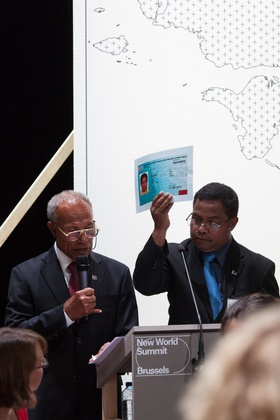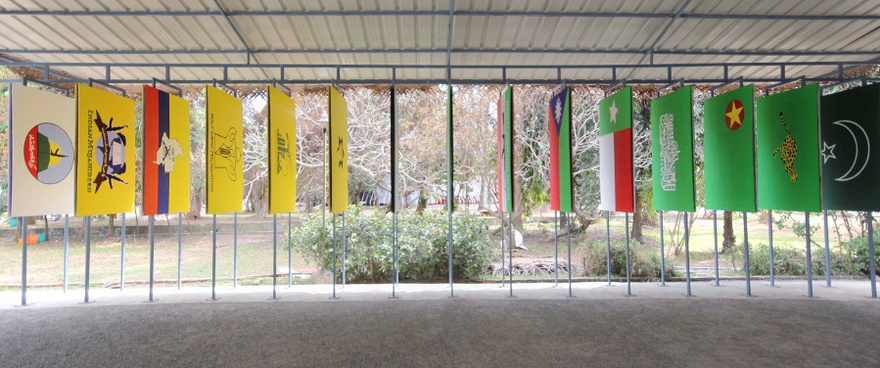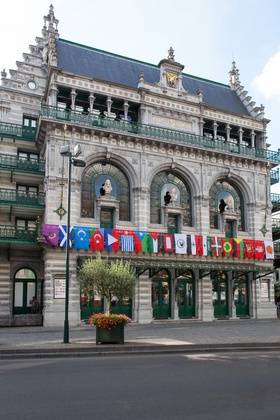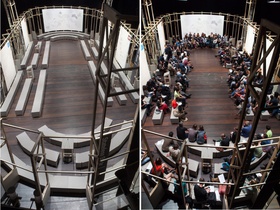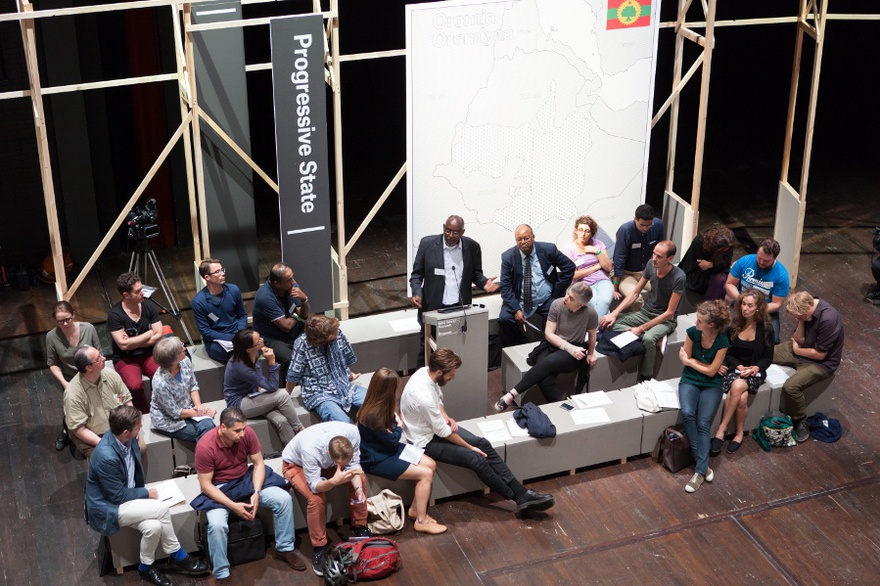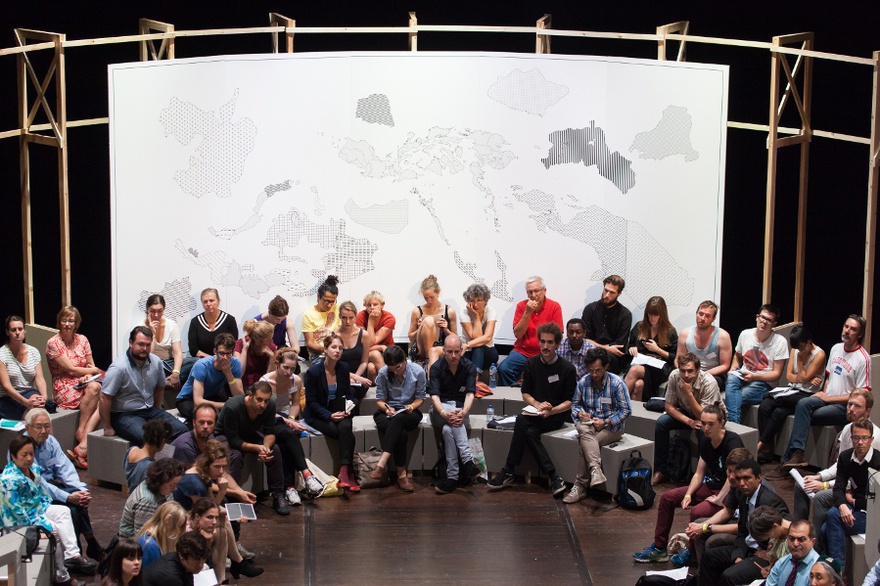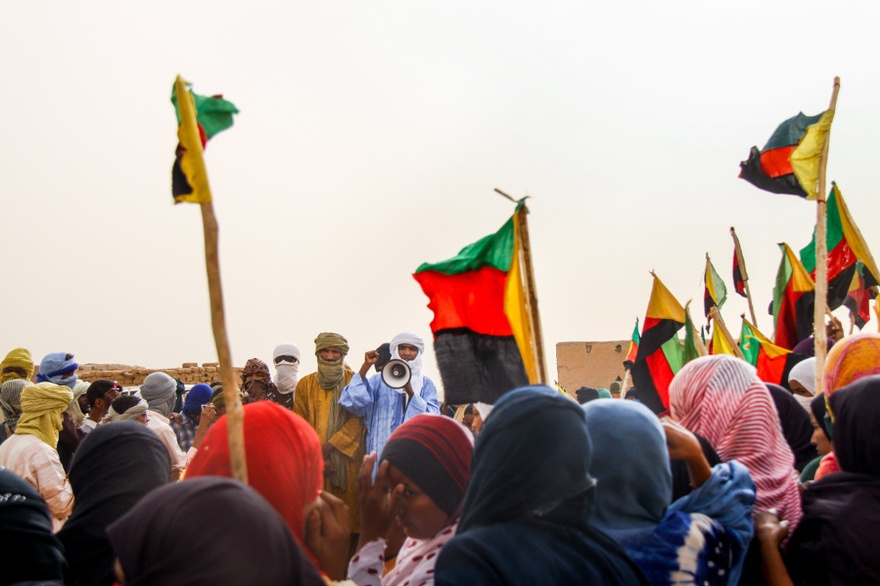Interviews
A New World Summit
Jonas Staal in conversation with Stephanie Bailey
The New World Summit is an artistic and political organization dedicated to providing 'alternative parliaments' by hosting political groups that have been excluded from democracy. Founded by artist Jonas Staal in 2012, the first summit took place in Berlin in May 2012 as part of the 7th Berlin Biennale, and hosted four political and three juridical representatives of organizations placed on internationally designated terrorist lists. The second summit, in Leiden, considered the economic, ideological, and juridical interests invested in upholding the notion of the 'terrorist' by inviting Professor Jose Maria Sison, co-founder of the Communist Party of the Philippines (CPP) and its armed wing, the New People's Army (NPA), as keynote speaker. The third summit took place in an open-air parliament built on the grounds of Aspinwall House, the main venue of the Kochi-Muziris Biennale, in 2012/2013, and was raided by the Kochi City Police with approval of the home department and state intelligence. Three members of the Summit, Staal included, were charged under the Unlawful Activities (Prevention) Act Section 10 (4). In this interview, which took place just after the first museum survey of the New World Summit's activities, The Art of the Stateless State, opened at the Museum of Contemporary Art Metelkova, Ljubljana, on 27 January 2014, Staal discusses the New World Summit project.
Stephanie Bailey: How did the New World Summit begin?
Jonas Staal: The project came out of my earlier work, which was related to the rise of ultranationalism in the context of the Netherlands. It was a response to the political context I was living in. This included the abandonment and destruction of a social democratic infrastructure that was developed after the Second World War, which shifted to a liberal democratic paradigm in the 1990s. Then, in the early 2000s, things took a very nationalist xenophobic turn parallel to the so-called War on Terror.
There is a relation between ultranationalism and the War on Terror, which I find fascinating. On the one hand, there is this need to reinsert the idea of sovereignty, but in doing so it outsources political power to fundamentally undemocratic political infrastructures and security apparatuses so as to protect established borders and national sovereignty. The result is, of course, an absolute contradiction: the protection of the nation state contributes systemically to the erosion of civil rights within that same nation state. This actually enforces a collective condition of statelessness: meaning, you are a citizen as long as you can prove your loyalty to a very perversely articulated idea of what it means to be one – say, to be Dutch, for example. This leads to questions surrounding how one relates to mythical heritages such as those the ultranationalists argue are the 'true' foundations of western society.
The New World Summit came from being very much invested in that specific condition I observed in the Netherlands and trying to understand the way that these limits of democracy and nation states were being enforced through extra-legal policies. And that's the question: what are the voices and political forces that are today considered to be inconsumable within the liberal democratic paradigm or, in this case, the xenophobic ultranationalist paradigm?
SB: What issues did you face when starting the project? The premise, after all, is ethically ambiguous: you invite organizations that are or have been classed as terrorists.
JS: As the project has developed, we have been confronted with the complexity of organizing something of this nature, which in a regular diplomatic sphere would not normally be allowed, and framing it as an artistic project. This doesn't mean that we're using the space of art just because it's an exceptional sphere in a juridical sense. I fundamentally believe that the exceptional space of art, with its radical ambiguity, offers a place where we can question and redefine what representation is. It is the ultimate and necessary political space to realize a project like this.
When we started, one of the greatest difficulties was funding. How do you fund a congress that facilitates groups that are considered to be opponents to the states where you are organizing them? In the case of the 7th Berlin Biennale, the main funder was the national cultural fund of Germany. When they realized that through supporting the Berlin Biennale they were supporting a project that would facilitate organizations that stand in direct conflict with their policies and engagements in the War on Terror, the project was cancelled because the cultural fund threated to pull out funding for the whole biennale. In a way, that is understandable: we asked the state to act against its very own interests. Nevertheless, we engaged in direct negotiation with the funding body and managed to claim the space for the summit. We were lucky to find a progressive ally at the heart of the organization willing to take the risk.
Another difficulty was to build a relationship of trust with these different groups we were working with. We wanted to be very transparent about where the summit would take place, what it would look like, and what it meant to organize it in the space of art. In this regard, the first summit was the most difficult. After that, it actually developed very quickly. Now there are many groups that ask if they can participate. So it's no longer a question of building the network, but dealing with the question of how to work with all these stateless substructures that could benefit from the New World Summit.
SB: Could you talk about the design of the spaces within which each summit is held, as well as the objects produced? There are the flags for unrecognized organizations you produced for the first summit, for instance, and the maps representing unrepresented states made for the fourth.
JS: For every summit we redesign the structure of the parliament, the theatrical space where we per-form politics. We believe that the form in which people assemble, and the visual conditions and imaginaries we are surrounded by or even implicated in during such gatherings, create the possibility of different outcomes and alliances. In a way, the programmes we develop for each summit inform our decisions on an ideological level – they are ideological blueprints for the design of the space, which responds directly to what we are trying to achieve or explore politically with the different groups we invite. For us, ideology is form.
For the 7th Berlin Biennale, all the flags were of organizations that are blacklisted or placed on terrorist blacklists. They were ordered by colour, not by geographical location or ideological orientation. All together, they created an abstraction, a colour scheme, but when addressed by the speakers, they regained their historical and pictorial specificity. The architecture and design of the summit is another way to question the conditions of representation in the form of the flag – essentially, a canvas. In the case of the summit in Brussels, we developed large-scale maps depicting the specific territory or ideal of statehood for each of the invited organizations. It was a crucial element, as it allowed to address a specific state in its ideal form: not 'Basque Country in present day Spain', but Basque Country tout court. This took more than one and a half years to create because we made each of the maps in collaboration with each of the groups. For example, in the case of Baluchistan there are so many maps that conflict, and oftentimes the groups themselves continue to change the lines of their territory. This may be because they themselves are not completely sure of where the boundaries lie, or because there are contestations between different factions within an organization about what exactly the territory they inhabit is historically.
SB: This relates to the space of the summit as a site of negotiation and contestation, and a platform for political voices that have been excluded from a larger global conversation. But while engaging in this kind of post-national rhetoric of the stateless state, do you think the New World Summit also asserts a kind of nationalism through the frames within which it operates – the 'global summit', for instance?
JS: It's interesting because I would never have thought of the project as a way of reinserting nationalism, but rather as a way to recognize different struggles that come from histories of national liberation. The political aims of the summit itself are to articulate practices of democracy that are inherently stateless. Not stateless in the sense of victimization, but statelessness as a precondition to rethink democracy as practice and not as something that is inherently tied to the structure of nation state. And that agenda, of course, is informed by the groups that we work with, most specifically the Kurdish Women's Movement, who have been predominant in the Kurdish Nationalist Movement to critique and redefine the patriarchal construct of the state, which they see as the main reason why the model of the state obstructs the practice of democracy as a radical plural form and differentiating practice. So the summit has also developed partly because of the exchanges and our understanding of the groups that we work with.
Of course, it's true that the majority of the groups participating in the New World Summit have a very specific idea of territorial space, which they believe they are entitled to inhabit. It's not my position to deny the necessity of such claims. For example, there is the National Liberation Movement of Azawad, which we have been very involved with and which consists mostly of peoples with a nomadic history from the north of Mali. For them, the idea of claiming a state was not part of their historical struggle at all because the whole nation state project is completely absent from their own history. It is something that they were forced into, or that was imposed on them – a logic and a language of geopolitics that they've had to learn to accept in order to demand some form of autonomy that could be recognized by the states that confronted them. But that is what it comes down to – it is not necessarily about the actual desire for the nation state as a project; it's just the only tool to gain a minimum of control over their own resources and lands. In this case, you're talking about a territory with no roads or running water or electricity or any infrastructure whatsoever. So then to critique the demand for a nation state or to tell a group to reject such a demand, in such a context, is absurd.
SB: As you say, the Azawad were forced into this project of the nation state, which was the case for many postcolonial states within the so-called Global South. It's fascinating to think about that in parallel to the New World Summit as an alternative parliament that is located in the heart of the western world, which replicates, to some extent, the structures of a parliamentary process we have come to know as a component of western democracy. There's so much at play, here, no less the assertion of autonomous identities within the frame of art and democracy.
JS: There is, of course, an ongoing critique around what level our summits are just another way of aestheticizing or depoliticizing struggles. But that is also a very specific western-based critique – it comes from a very specific understanding of what art is and what it can and can't do. It's a critique that presumes that the space of art by definition is the space of simulacrums; that it has to be a place where we question the conditions of representation but where it can never be about creating presence in a different form. Western art history tells us that art is about representation; we claim the space of art as one of political transformation.
What we have learned from the many artists that are involved within the stateless movements that we work with is that this perception of art as a simulacra is not shared at all. The role of art within stateless states, which is something we've also made part of the exhibition in Moderna Galerija, often takes the form of an alternative to the state. So in a stateless condition, when there's no state to rely on to administer your identity, the practice of art, literature, poetry and music becomes a way of keeping and performing a common memory through specific cultural and symbolic vocabularies. I didn't realize this at the beginning of the project, but slowly I began to understand that with the confrontations between existing states and stateless states, you also have confrontations between fundamentally different understandings of cultural practice. Within the existing state, art is depoliticized as a space of 'mere representation'. In the context of the stateless state, art sometimes is the only means of representation left, thus deeply politicizing art, and defining it as the very foundation of the state building project.
SB: That connects to this apparent transition taking place: this move from the twentieth century nation state model to a kind of twenty-first century assertion of a new form of autonomy that seeks to transcend pre-defined or imposed borders and structures. This recalls what Adem Uzun, a leading official of the Kurdish National Congress (KNK), said in Brussels at the fourth Summit: that it is in the Kurdish interest to engage directly with the political situations in each of the nations the Kurds live since this is the only way they can gain agency. Then you have the National Democratic Front of the Philippines, which acts as a kind of para-state – a state within a state providing infrastructures to those excluded or supressed by the state proper.
JS: This whole question of autonomy is interesting because in my own practice in the last ten years I have systemically critiqued the concept of autonomy and the way that it is used in the domain of art, which hails back to a modernist-turned liberal democratic idea of what the freedom of the artist is or asserts. The powerlessness of the autonomy of art becomes well apparent in the movement of institutional critique: we are allowed, even motivated, to question endlessly the conditions of our own practice, but we're not allowed to change anything. Asking questions is considered inherent to art, while political action disqualifies it as mere 'activism' or 'propaganda'. Of course this is the real propaganda: the idea that art is only really art if it remains outside the field of actual political struggle. It's a logic that serves the status-quo. Of course, within the context of the summit, the role of art and autonomy in a political sense is put into question.
SB: Which brings us to the provocations of the New World Summit, and the problems inherent in the project. Consider the first and second summits, for instance, which toed that ambiguous line when it comes to condoning violence and terrorism. One could counter: could ISIS not fit into such a frame? It is, after all, a 'stateless state' in many ways: something that recalls Appadurai's concept of the diasporic public sphere – the crucible of a postnational order. I wonder how you feel about this undercurrent of violence – and the indirect support of it – that permeates the project from an ethical perspective?
JS: On the question of ISIS participating in the summit, this naturally wouldn't happen because many groups that are blacklisted or that are confronted with conditions of statelessness are not at all powerless. They have their own media apparatus and they have no interest whatsoever in joining a space occupied by groups that are radically opposed to their ideology. Many groups that join the summit often have very conflicting interests – sometimes they are even claiming the same space. For example, the three groups with a stake in Iran that were at the summit in Brussels – the Al-Ahwazi Alliance, the Baluchistan People's Party and the Southern Azerbijan Alliance – have also had to resolve a lot of conflict amongst themselves because their territories overlap. Here, the Kurdish model of Democratic Confederalism, of autonomous functioning structures that exist in a parallel universe but acknowledge and respect one another's difference when it comes to language culture and history, could be an interesting response.
But the point you are raising about Islamic State is interesting. I just finished transcribing an interview with Dilar Dirik, who was the last speaker on the Stateless States block in Brussels, in which she discusses the new autonomous Kurdish zones that have been created in the northern part of Syria. There is a specific internal critique on the project of national liberation that was fuelled by the Kurdish Women's Movement, which is the analysis that the nation state is an inherently patriarchal construct that has to be separated from the practices of democracy if the liberational or emancipatory dimension of democracy wants to manifest itself. Dirik juxtaposes this project of a stateless democracy as proposed by the Kurdish Women's Movement with their main enemy, the Islamic State, who they are fighting at their borders, and who follow the logic of a 'total state'. In this case, the difference between a stateless democracy on one side of the border versus the total state on the other could not be more fundamental.
ISIS's films are actually quite interesting: their propaganda shows that they, too, are informed at least in part as an anti-colonial movement. They specifically reference enforced borders as the departure point and historical legitimation for their movement to exist in the first place. Then again, the form ISIS takes, which is the form of the total state, perfectly mimics the structure of today's security apparatus: structures that have been developed since the global War on Terror began. These extra-legal structures no longer recognize nation states but continue to preach democracy to the world while functioning with structures and policies that are in complete contradiction. This is a reflection on how both sides act as perfect mirrors, or two sides of the same coin: between the Coalition of the Willing and ISIS there is, unfortunately, not much of a choice. The third way, the critique of the model of the total state altogether, comes from the Kurdish Women's Movement..
SB: This notion of a mirror reflection points to issues of division, such as those between the so-called 'North' and 'South' or 'East' and 'West'. During the fourth summit in Brussels, Stateless States, there was a moment in which such divisions became visible within the frame of the project itself. Jolle Demmers, Associate Professor and co-founder of the Centre for Conflict Studies, Utrecht University, The Netherlands, convened the summit's final Q and A, and cut someone off from the floor who wanted to speak with regard to the Tamil issues being discussed at the time. It was when the summit revealed itself to be a space within which power is not always negotiated equally. In some ways, it also pointed to the fact that the New World Summit is a western, European-supported project that has been masterminded by you: it operates within a framework you devised. How do you position yourself in relation to the project, and the conditions in which the summit takes place?
JS: This is a question I've been asking myself a great deal. My original position was clearer because my work was invested in the specific cultural and political heritage of the country I am living in, which I think should be the starting point for any artist engaged with questions of politics and political representation. You need to somehow try to understand what it is that makes you who you are, what history you are indebted to, and consider who it is that you are serving or who's power or interests your work might be instrumentalized for.
The New World Summit came as a result of wanting to show the 'other side' of ultranationalism: the political organizations and movements repressed from the political realm in the War on Terror. But I myself was not born in a country that was a product of national liberation – I was born in the heart of empire. So that makes my position, of course, very problematic in relation to the agenda of decolonization that the New World Summit strives for. Inevitably, what is at stake is the decolonization of the self as well as the structures of oppression that the groups speaking at the summit are confronted with.
But there is of course an inherent imbalance of power at the basis of the summit: between us, as organizers, who have one or even several passports in our pockets, and political organizations and groups whose very basis of existence, to the point of the difference between life and death, is radically precarious and vulnerable. The New World Summit seeks to overcome that imbalance. But of course, the unfortunate starting point is this terrible inequality. That said, do not mistake the groups that we work with as mere 'victims' – though they are forced into a position of oppression, they are also the proud embodiments of the capacity to resist, to imagine, and to act in the world differently. The parallel revolutionary state of the Philippines, the government of Azawad, the practice of democratic confederalism in Rojava: these might not be recognized structures of politics, meaning that they are under immediate embargo and often prosecutions, but they most certainly exist. Dilar Dirik calls that 'living without approval'; to exert autonomy in a process of self-recognition. We do not pretend that these are movements that are somehow begging for a next NGO or IMF to come to the rescue. What they are saying is the opposite: get out of our way.
And at the same time, the space of the New World Summit really does belong to the organizations that participate. In the case of the fourth summit in Brussels, there was not one organization that did not make the space theirs. They completely owned it, and used it as an instrument, politicizing the space in a way that we could not. We can create the conditions for a different politics in a visual, infrastructural way, but only when these are practiced and recognized by others as meaningful, do they actually gain political agency. The summit's organization sets the conditions for this political performance to take place, but the meaning it has and its capacity to actually build new infrastructures and coalitions between different groups is something that we cannot control or direct, but which happens nonetheless.
SB: The history of imperialism in the last five hundred or so years, of which the Netherlands is indeed at the heart, is a legacy that still shapes the way the world is developing. I wanted to think about this in relation to what you mentioned in Brussels: that the New World Summit is fundamentally a phenomenological study into how political systems might evolve in the future while considering the history of such systems. In the work you've done with different political groups and organizations, what systems do you see emerging?
JS: What is really crucial to note is that my research into the rise of ultranationalism and the work I'm doing with the New World Summit takes place in the context of the War on Terror: that is the age that has defined my specific engagement and politicization. Suthaharan Nadarajah, who spoke on behalf of Tamil Eelam at the fourth summit in Brussels, explained this really well: the War on Terror functions as part of a neo-colonial project of state building. The blacklisting of groups that come from a history of national liberation and anti-colonial movements and the demand towards such groups to lay down arms has everything to do with clearing the space for the new condition of empire to manifest itself. But this is no longer empire in the sense of nation states taking over spaces in a defined territorial sense. It is about a condition that is much more difficult to grasp: how corporate politics is tied to the nation state project or how the nation state functions as a 'colony of capital', as Abdullah Öcalan said, that is abandoning its own formal territorial boundaries.
The idea of the nation is still asserted in political rhetoric so as to maintain a mythical idea of unity within the state, but the state's actual loyalties and functioning take place completely outside of that paradigm. In a way, the nation state has already ceased to exist completely, but it still functions as point of orientation; as something that represses the anxiety of its own citizens' knowledge that they are part of a system that's already far beyond their control. That's part of the very complex geopolitical structure that the summit tries to position itself into and in which it tries to articulate this hope or possibility of what we've come to refer to as 'a stateless international'; or a rebuilding of solidarities between different stateless political movements worldwide, both historically and more contemporarily.
The idea of rebuilding these solidarities and rethinking what democracy could be takes as a departure point the disappearance of the nation state paradigm as our leading paradigm for the twenty-first century. The presence at the fourth summit, for example, of the International Pirate Parties and Women on Waves was, for me, quite crucial because it's also about showing that twenty-first century political movements are also historically indebted to movements of national liberation.
SB: Are you asserting these organizations and movements are showing us what is to come?
JS: We just came back from conducting research in the northern part of Syria where the Kurdish movement has taken control largely of the northern region. They were able to do this because Assad was fighting the Free Syrian Army, thus leaving this power vacuum where the Kurdish movement was able to take over and start to build what they refer to as Democratic Confederalism. It is the idea of a stateless democracy: a series of autonomous zones that stand on their own self-governance. This model of a stateless democracy is termed by the Kurdish movement themselves as their 'third way'. That, of course, consciously refers to the legacy of 'Third World-ism' – not in terms of victimization, or even to those who were left behind in establishing global politics. Rather, it refers to those who can now lead us out of the mess global politics has created, which corresponds to the politics of the summit itself.
What's crucial to note here, though, is that the first summit in Berlin was an artistic project. It was my project and it was never meant to become an organization. I never thought of it that way. It was an attempt to question, after ten years of The War on Terror, how the so-called limits of democracy are established. It asked: who are the ones that are being placed outside of that framework? What is it that we can learn from these specific discourses? These questions responded to our own condition living in states creating its own states of exception, abandoning the rule of law. So what can we learn from those who have been placed outside of such a condition, and what is our indebtedness to these specific groups? This is actually how we got to know about the Kurdish Women's Movement in particular. We soon realised that the New World Summit should not be understood as a project, but rather as an endeavour with a much longer lifespan.
SB: Let's consider this in relation to the exhibition that recently opened at the Museum of Contemporary Art Metelkova, Ljubljana, The Art of the Stateless State, which presents an overview of the New World Summit for the first time. What does this exhibition express or communicate in terms of how the project started and how it has evolved?
JS: For me, it has been a bit of a challenge because before this show, we only ever participated in group exhibitions that the summit could function in or contribute to, like research platforms or the 7th Berlin Biennale. We had never really presented the summit as an exhibition in and of itself, partly because the purpose of the project is not to create exhibitions. But this show in Ljubljana was a chance to look at the methodology we have developed since we started. It also allowed us to emphasize the relation between the spatial constructions that we create, the sociography that we propose, and the performative dimensions of politics we explore: we did that by transposing large parts of our architectural constructions to restructure the exhibition spaces themselves so as to fully implicate a visitor in the infrastructure of the summit. Producing the exhibition also gave us an opportunity to see the results of the summit in terms of the groups that were able to facilitate the collaboration, and to consider how our partners contributed to their struggle: these partners being the Progressive Lawyers Network and the Unrepresented Nations and Peoples Organization (UNPO). It's as much an exhibition of a methodology, but also of an alliance: of the many voices that have so far developed through and within the summit. These new social relations are of course the real architecture, and the real work that we hope to contribute to.
SB: How would you summarize the summit's intentions at this point?
JS: The summit is as much about the right of equal representation of state and non-state actors as it is about a search for what could be an alternative: a coalition founded on an internationalist sphere that articulates solidarities and can collectively articulate a critique or an alternative to the nation state paradigm. It's about asserting the right of peoples before that of states, and making visible the radical diversity of political struggle that takes places in our world today.
But still, the mantra of the so-called end of history is alive and kicking – the only historical narrative left to us seems to be the one that declares its own disappearance, again and again. This has everything to do with not wanting to acknowledge that there are actually choices and alternative worlds being built right in front of our eyes but that don't enter into common debate. The Kurdish struggle and their articulation of Democratic Confederalism, for instance, already took place at the end of the 1990s but it's only now, because they are implicated in a war that has geopolitical interests, that the international powers and media are actually becoming aware of it and taking notice. And then, as I said, our goal is to contribute to the practice of stateless democracy, and establish a stateless international. The summit should not just be about 'listening' to alternatives. It's about making worlds. Many worlds.
SB: Theoretically, how do you consider the summit in spatial terms? Would you consider these summits operating like semi-autonomous or free zones, for example? Can you talk about the theories and histories that really fed into the conceptualization of the summit as an idea?
JS: We've been looking a lot at the history of micro-states and the notion of the temporary autonomous zones, as developed by Hakim Bey. The model of the temporary autonomous zone has a historically subversive aspect to it, though today they can be islands that Brad Pitt buys for his daughters or the new extra-territorial structures being built by Google.
Of course, there is this ambiguity to the idea of the parliament that we are proposing: one with a nomadic structure. This kind of structure is not directly related to a specific territorial space, so it also touches on this very libertarian, almost corporate tendency that you see taking place now. The extra-territorial space is also a non-protected space; it does not necessarily propose an emancipatory freedom.
This of course brings us back to the difficulty of abandoning the nation state project as it is. I think the critique of the state is legitimate but maybe the question that we are confronted with is much more about how we radicalize the emancipatory promise of the state than abandoning that whole trajectory altogether. Historically speaking, the state system made it possible to think of people as no longer constructed by direct ethnic, class-based or religious interests – it articulated the idea of people as common even though that commonality was not marked by a blood line. This was something absolutely revolutionary.
Yet, to articulate common interests beyond direct personal ethnic, or class-based or religious interests, is the trickiest aspect of the Kurdish model, which I otherwise really support and that we have learned so much from. The difficulty of Democratic Confederalism, the idea that everyone has their own government or the idea that everyone has the right to build their own autonomous entity, is that it fits into this discourse of the commons today, in which a kind of association is created between people who then share benefits from their cooperatives. This has been celebrated as a way out of the oppression of the corporate-state and so on. But these cooperatives are often very strongly rooted in specific class interests – you only start a cooperative with someone that you have an interest in; in other words, if they are as productive or potentially more productive than yourself. But it totally denies the fact that a huge part of our population is not 'productive' and cannot be productive even if they want to be. In such a context, social security becomes a question of 'charity': there are no mechanisms in place that enforce solidarity. I think the question of abandoning the state by radicalizing its social and broad collective potential is where the emphasis should be. Only then can we challenge these very oppressive notions of 'productivity' and class interest in the first place.
SB: When you talk about radicalizing the state, do you mean concentrating on the state while doing away with the nation?
JS: This is interesting because many of the groups that we work with propose it the other way round – they want to abandon the state but emphasize the fundaments of the nation. The nation being the people. But of course, then comes the question that has been asked a lot at the summit – what constructs define, judicially speaking, a people?

